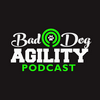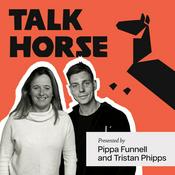382 episodes

376: Optimal Lines in Agility
04/12/2025 | 28 mins.
In this episode (28:39) This week on the podcast, we take a closer look at how dogs actually run a course and what handlers can do to help them run it faster and with more confidence. We explain why dogs run lines rather than individual obstacles and how understanding your dog's stride, structure, and turning ability helps you choose the best line for any sequence. We also talk about why the fastest path is not always the shortest and how video comparison reveals the true optimal line for your dog. You Will Learn Why you should handle lines, not individual obstacles How pulling, position, and continuous cues shape your dog's line Why tight turns slow dogs and when a wider arc is actually faster How to compare options on video to find the best line for your dog Mentioned Episode 179: Which is Faster, a Front Cross or Rear Cross? Episode 108: Choices on Course Sponsored By Saint Rocco's Treats Canine Handler Fitness

375: When Stress Hijacks Your Handling
20/11/2025 | 30 mins.
In this episode (30:01) In this episode, we break down why so many handlers walk to the start line with a clear plan and instantly forget everything the moment the run begins. You Will Learn Why your brain blanks on course and how stress shuts down the prefrontal cortex, reducing timing, sequencing, and decision-making. How adrenaline affects handling, including tunnel vision, and reversion to default movement patterns. What the Yerkes-Dodson curve tells us about optimal arousal for performance and why beginners fall off the curve sooner. How to use the physiological sigh as a rapid, science-based tool to reset your nervous system right before a run. Mentioned Episode 159: Handler Muscle Memory for Dog Agility Episode 188: Handler Desensitization Sponsored By: Canine Handler Fitness with Liz Joyce

374: Fail Better
13/11/2025 | 22 mins.
In this episode (20:34) In this episode, Esteban and Sarah talk about what it really means when things go wrong in the ring. A knocked bar, a wrong course, a dog that runs straight to the leash—none of these moments predict your future in agility. Instead, they're feedback about where you and your dog are in your training journey. You Will Learn The key difference between formative and summative feedback—and how it applies to training and trials. Why tying your success or failure to self-worth actually slows progress (and how to stop doing it). How to read your dog's "mistakes" as information about confidence, arousal, and understanding. Thank You for Listening! Thanks so much for joining us this week. To get Bad Dog Agility podcasts sent directly to your device as they become available, you can subscribe on iTunes, SoundCloud, or Spotify. Happy training and thank you for helping us reach over 2 million podcast downloads! Sponsored By: Canine Handler Fitness with Liz Joyce

373: Burnout in Dog Agility
06/11/2025 | 37 mins.
In this episode (37:02) Burnout isn't just something that happens at work—it happens in dog agility, too. In this episode, we dive into what burnout looks like for handlers, why it happens, and how to recover in a healthy way. You Will Learn The three major predictors of burnout identified across 30+ studies: Why agility is uniquely vulnerable to burnout (and what's missing compared to other sports). Practical ways to recover and prevent burnout for both you and your dog. Sponsored By Saint Rocco's Treats Clip & Go Agility

372: "My Dog Deserves Better"
30/10/2025 | 20 mins.
In this episode (20:34) We've all said it. "My dog deserves better." Maybe after a missed contact, a wide turn, or one of those runs where nothing clicks. But what does that phrase really mean? In this episode, we look at where it comes from, how it shapes the way we see ourselves as handlers, and what our dogs actually need from us. You Will Learn Why "my dog deserves better" comes from love and care, but can slowly turn into guilt. How to tell the difference between healthy accountability and self-blame that holds you back. Why having a super talented dog can feel like pressure instead of joy, and how to flip that around. Esteban's advice to reframe your language so it builds confidence instead of doubt. Thank You for Listening! Thanks so much for joining us this week. To get Bad Dog Agility podcasts sent directly to your device as they become available, you can subscribe on iTunes, SoundCloud, or Spotify. Happy training and thank you for helping us reach over 2 million podcast downloads! Sponsored By: Canine Handler Fitness with Liz Joyce Clip and Go Agility
More Leisure podcasts
Trending Leisure podcasts
About Bad Dog Agility Podcast
Listen to Bad Dog Agility Podcast, 天真不天真 and many other podcasts from around the world with the radio.net app

Get the free radio.net app
- Stations and podcasts to bookmark
- Stream via Wi-Fi or Bluetooth
- Supports Carplay & Android Auto
- Many other app features
Get the free radio.net app
- Stations and podcasts to bookmark
- Stream via Wi-Fi or Bluetooth
- Supports Carplay & Android Auto
- Many other app features


Bad Dog Agility Podcast
download the app,
start listening.































